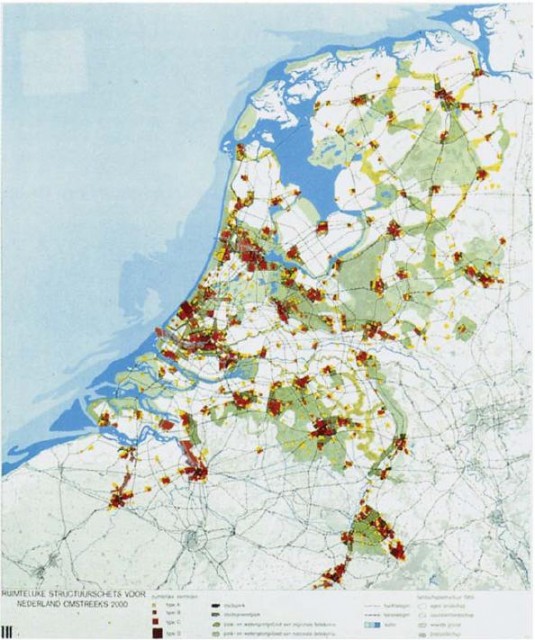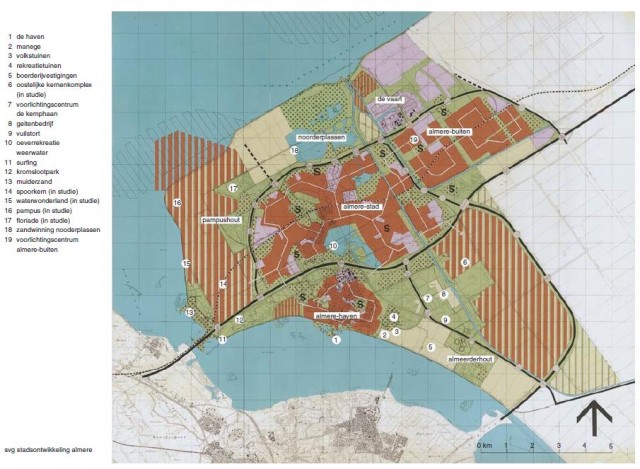Few Examples of Territorial Development Policies
Netherlands
It has already been said that Netherlands practiced territorial development before this expression was used. However, it has not been before 1962 that an act instituted territorial plans at the national scale. There has been, up to now, five such plans, plus revisions of some of them. This means that it is an evolutive planning, indicating priorities that can evolve:
- in the second plan (1966), the limitation of the growth of the Randstad, large conurbation in the west of the country (Amsterdam, Rotterdam, Den Haag, Utrecht, etc.) (Figure 2);
- in the third plan (1974–77), the constraints of the environment and a policy of new towns (groeikernen) for the overspill of big cities;
- in the third plan revised (1983–85), the policy of the 'compact city' appeared;
- in the fourth plan (1988), the search of quality and the reinforcement of large cities;
- in the fourth plan 'extra' (1991), a policy of localization of activities according to their relation with the transportation networks; and
- in the fifth plan (2001), urban reorganization, intensification of the use of land, and search for a greener space.
These national plans have been declined through the provincial and local plans.

Parallel to this huge effort of planning, spectacular projects were developed:
- the development of the Zuyderzee gulf by closing it with a 30 km long dyke (1932) and the creation of a vast lake (Ijsselmeer) behind the dyke and, in this lake, the construction of four polders (166 000 ha) devoted to agriculture with new villages and towns (Figure 3); and
- the closing of the delta, common to Rhine, Maas, and Scheldt through a double range of obstacles: bridges c. 25 km from the shore and of dams right at the shore.
Britain
Territorial development has been a priority after the Barlow Report (1940) and until the end of the 1970s. It had two main lines:
- the control of the growth of large conurbations, particularly London, with the Abercrombie Plan (1944) and the construction, around London and other big cities, of new towns (New Town Act, 1946) and of expanding towns (Town Development Act, 1952); and
- the decentralization of manufacturing (necessity to get an industrial development certificate, from 1947) and later of tertiary (Office permit, 1963) activities outside the London region, preferentially toward underindustrialized or declining areas ('development areas', created in 1945), where aids, financial or others were attributed.
This policy, very willful, has been however braked down by the Labour government after the oil crisis (1973–74), then given up by the Thatcher government in the early 1980s, to be replaced by a policy of economic (Urban programs, 1977, City grants, 1982) and spatial (Urban development corporations, particularly for the renewal of London Docklands and of the Merseyside in Liverpool) revitalization using methods and capital of the private sector.

France
It is only after World War II that France has attempted to have a territorial development policy. As in Britain, the departure point was the concentration, considered as excessive, of population, activities, amenities and, decision of power in and around Paris.
The first measures (Agrement to create or develop factories, and later any activity building, instituted in 1955), financial (prime d'amenagement du territoire) and fiscal aids to the firms creating activities in other regions, aimed to decentralize activities and to develop other big cities, which were to become metropoles d'equilibre (1964) (Figure 4). The Delegation a lamenagement du territoire et a` l'action regionale (DATAR) was created in 1963 to implement these policies.
However, the latter has been inflected, then re oriented, notably after the oil crisis (1974) and new pri orities (economic, social, and environmental) appeared:
- planning and development (nonagricultural activities and amenities) in the rural areas;
- preservation of the environment: creation of national and regional parks, of natural reserves, conciliation, on the littoral, and in mountainous areas, of the objectives of economic and development of tourism and of protection; and
- correction of the physical, economic, and social degradation in the collective housing estates (grands ensembles) built between 1955 and 1975. At the same time, the institutional context has been modified:
- administrative decentralization (1982–83, reinforced in 2004) by transfer of competences from the state to regions, departements, and municipalities; and
- encouragement (acts of 1992 and 1999) to the grouping of municipalities (they are 36 784) by creation of communautes urbaines (for large conurbations), communautes d'agglomeration (for smaller ones), and communautes de communes (in mostly rural areas).
An Example of a Developing Country: Lebanon
As Netherlands, Lebanon is a good example of the necessity of a territorial development. Beyond its contrasted relief, its exiguous territory (11 000 km2 for 4 million inhabitants), the opposition between Beyrouth metropolis and the rest of the country, Lebanon is split from the religious point of view. The 1943 constitution and the Taef agreement (1992), and also the long Civil War (1975–90), had for result that this religious division became the base of the institutional organization of the country. Therefore, it is an absolute necessity that territorial development contributes to cement the national unity. But, as different from Netherlands, there is, in Lebanon, no consensus around territorial development.

A Schema directeur d'amenagement du territoire libanais has however been published. Its proposals aim at a unitary and integrated development of the national territory and at a rationalization of the use of resources, including water. For that purpose, this plan, beyond a proposed distribution of land, for which it specifies the rules to apply, advocates a reorganization of the territory around powerful urban poles, an economic development balanced between all the regions, the creation of a performing transportation network, and an oriented distribution of important amenities. The implementation of this plan has, however, to face the maintenance of religious and political conflicts, the difficulty to assert national independence, the habit of nonrespect of the rules, and the weight of private capital not very concerned with the general interest.
Conclusion
Besides the five dilemmas that any policy of territorial development must face, the four examples presented underline the risk of a lack of continuity in the actions, new priorities tending constantly to replace the previous ones.
A policy of territorial development, not to be a simple alibi, needs a strong will of intervention to orientate the economic, social, and spatial choices; an agreement to reject the primate of economy, despite the globalization induces at it; a will of spatial and social equity; and a concern with care for nature.
These principles must be understood independently of any ideological preference, except the search of the general interest. However, they suppose a wide consensus around societal values to give an answer to the three major crises (energy, climate, and society) of the twelfth century. A policy of territorial planning will then encounter conditions that will make possible that it participates, at all the scales, to a real sustainable development.
- The Five Great Dilemmas of Territorial Development
- First Experiments
- Which Scientific Status for Territorial Development?
- What Is Amenagement du Territoire or Territorial Development?
- Amenagement du Territoire: Territorial Development
- Critical Contemporary Aid Debates
- Humanitarian Aid
- Aid Conditionality
- Changing Trends in Development Aid